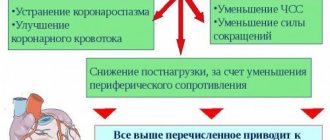Omnopon instructions for use
INSTRUCTIONS for medical use of the drug OMNOPON
Dosage form: solution for subcutaneous administration Composition: 1 ml of solution contains:
Active ingredients: morphine hydrochloride - 5.75 mg or 11.5 mg. narcotine - 2.7 mg or 5.4 mg, papaverine hydrochloride - 0.36 mg or 0.72 mg, codeine - 0.72 mg or 1.44 mg, thebaine - 0.05 mg or 0.1 mg.
Excipients: disodium salt of ethylenediaminetetraacetic acid (disodium edetate), glycerin (glycerol), 1M hydrochloric acid solution, water for injection.
Description: Transparent colorless or light yellow liquid
Pharmacotherapeutic group: Analgesic narcotic
ATX code N02AX
PHARMACOLOGICAL PROPERTIES Omnopon - Refers to list II of the List of narcotic drugs, psychotropic substances and their precursors subject to control in the Russian Federation. The main pharmacological properties of omnopon are due to the morphine it contains. Morphine is an agonist of predominantly mu-opioid receptors, activates the endogenous antinociceptive system and thus disrupts the interneuronal transmission of pain impulses at various levels of the central nervous system, and also changes the emotional coloring of pain, affecting the higher parts of the brain.
Pharmacodynamics Omnopon increases the threshold of pain sensitivity, inhibits conditioned reflexes, causes euphoria and has a moderate hypnotic and central antitussive effect, increases the tone of the vagus nerve center, stimulates the vomiting center, depresses the respiratory center, causes constriction of the pupil due to activation of the oculomotor nerve center, weakens intestinal motility, inhibits the secretory activity of the glands of the gastrointestinal tract. Slightly reduces basal metabolism and body temperature. Stimulates the release of antidiuretic hormone. When omnopon is administered subcutaneously, the analgesic effect develops within 10-15 minutes and lasts for 3-5 hours. Papaverine hydrochloride is an antispasmodic agent that has a hypotensive effect, reduces tone and relaxes the smooth muscles of internal organs and blood vessels. Due to the content of papaverine, omnopon causes spasms of the smooth muscles of internal organs to a lesser extent than morphine. Codeine is a natural narcotic analgesic from the group of opiate receptor agonists. Analgesic activity is due to stimulation of opiate receptors in various parts of the central nervous system and peripheral tissues, leading to stimulation of the antinociceptive system and a change in the emotional perception of pain. Narcotine is an opioid alkaloid that suppresses the cough center.
Pharmacokinetics The volume of distribution of morphine is 4 l/kg. 30-35% of the drug is bound to plasma proteins. Morphine is excreted from the body in the form of glucuronide metabolites (up to 80%) or unchanged, mainly through the kidneys; a small part is excreted in bile and excreted in feces. The drug crosses the placental barrier and is found in breast milk. Papaverine undergoes biotransformation in the liver. It is excreted by the kidneys mainly in the form of metabolites. In plasma it binds to proteins. Codeine undergoes biotransformation in the liver, with 10% becoming mofin by demethylation. Excreted by the kidneys 5-15% in the form of codeine and 10% in the form of morphine and its metabolites. Communication with plasma proteins is insignificant.
Indications for use Severe pain syndrome of various origins, both acute and chronic (myocardial infarction, trauma, post-traumatic period, malignant neoplasms, in preparation for surgery and in the postoperative period, etc.). Pain syndrome (renal, hepatic, intestinal colic in combination with myotropic antispasmodics or atropine-like drugs).
Contraindications Hypersensitivity to the components of the drug. Conditions accompanied by respiratory depression or severe depression of the central nervous system. Convulsive states. Increased intracranial pressure. Head injury. Bronchial asthma. Paralytic ileus. Heart failure due to chronic lung diseases. Cardiac arrhythmias. Acute surgical diseases of the abdominal organs before diagnosis. Conditions after surgical interventions on the biliary tract. Co-administration with monoamine oxidase inhibitors and for 14 days after their discontinuation. Children under 2 years old. During pregnancy, childbirth and during breastfeeding, the use of Omnopon is permissible only for health reasons (the development of drug dependence in the fetus and newborn is possible). With caution - elderly patients, with general exhaustion, with liver and kidney disease, insufficiency of the adrenal cortex, patients with a history of indicating dependence on opioids.
Method of administration and dosage Doses of the drug are selected individually depending on the severity of the pain syndrome, age and condition of the patient. Typically, adults are administered subcutaneously 1 ml of a 1% or 2% solution. If necessary, the drug is re-administered after 4-5 hours. The highest single dose is 30 mg (3 ml of 1% solution or 1.5 ml of 2% solution), the highest daily dose is 100 mg (10 ml of 1% solution or 5 ml of 2% solution). For children over 2 years of age, the drug is prescribed in a dose of 1 mg (age 2-3 years) to 7.5 mg (age 12-14 years), taking into account the general condition and the required degree of pain relief.
Side effects Euphoria, urinary disorders, allergic reactions, depression, hallucinations, nausea, less commonly vomiting, dizziness, muscle weakness, constipation. Drowsiness or agitation, exacerbation of brain diseases due to increased intracranial pressure, spasms of the biliary tract and bladder sphincter, and moderate respiratory depression are also possible. To reduce side effects on the intestines, laxatives should be prescribed. Strengthens the inhibitory effect on the central nervous system of anesthesia, sleeping pills, sedatives, antihistamines with a central component of action, antidepressants, anxiolytic and antipsychotic drugs. Causes addiction and drug (opioid) dependence (physical and mental). Causes dilation of peripheral blood vessels and release of histamine, which can lead to bronchospasm and hypotension. redness of the skin, increased sweating, redness of the white membrane of the eyes. With repeated use of Omnopon for 1-2 weeks (sometimes for 2-3 days), addiction (weakening of the analgesic effect) and opioid drug dependence may develop. 1-2 days after stopping the use of the drug, signs of withdrawal syndrome may appear (mydriasis, yawning, muscle contractions, headache, sweating, vomiting, diarrhea, tachycardia, hyperthermia, hypertension and other vegetative symptoms), which requires treatment in a specialized department.
Overdose Symptoms: stuporous or comatose state, hypothermia, decreased blood pressure, respiratory depression is observed. A characteristic sign is pronounced constriction of the pupils (with significant hypoxia, the pupils may be dilated). Treatment: maintaining adequate pulmonary ventilation. Intravenous administration of the specific opioid antagonist naloxone in a dose of 0.4 to 2 mg quickly restores breathing. If there is no effect, the administration of naloxone is repeated after 2-3 minutes. The starting dose of naloxone for children is 0.01 mg/kg. The short duration of action of naloxone should be taken into account. It is also necessary to remember about the possibility of developing withdrawal syndrome when administering naloxone to patients with addiction to morphs and similar drugs - in such cases, the dose of the antagonist should be increased gradually.
Interaction with other drugs Under close supervision and in reduced doses, OMNOPON should be used against the background of the effects of anesthetics, hypnotics, and anxiolytics. antidepressants and antipsychotics to avoid excessive depression of the central nervous system and suppression of the activity of the respiratory center. OMNOPON should not be combined with narcotic analgesics from the group of partial agonists (buprenorphine, tramadol) and agonists-antagonists (nalbuphine, butorphanol) of opioid receptors due to the risk of weakening analgesia and the possibility of provoking withdrawal syndrome. The analgesic effect and undesirable effects of opioid agonists (promedol, fentanyl) in the therapeutic dose range are summarized with the effects of OMNOPONA.
Special instructions During the treatment period, it is necessary to refrain from engaging in potentially hazardous activities that require increased concentration and speed of psychomotor reactions.
Release form Solution for subcutaneous administration. Ampoules of 1 ml containing 1% or 2% solution. 5 ampoules in a blister pack. 1-2 blister packs per cardboard box or 20, 50 or 100 blister packs (for hospital use).
Storage conditions Store in a place protected from light at a temperature not exceeding 15 degrees List II. List of narcotic drugs, psychotropic substances and their precursors subject to control of the Russian Federation. Keep out of the reach of children!
Shelf life: 3 years. It is prohibited to use the drug after the date indicated on the package.
Dispensing conditions Dispensed from pharmacies on prescription with the same restrictions as other narcotic analgesics.

